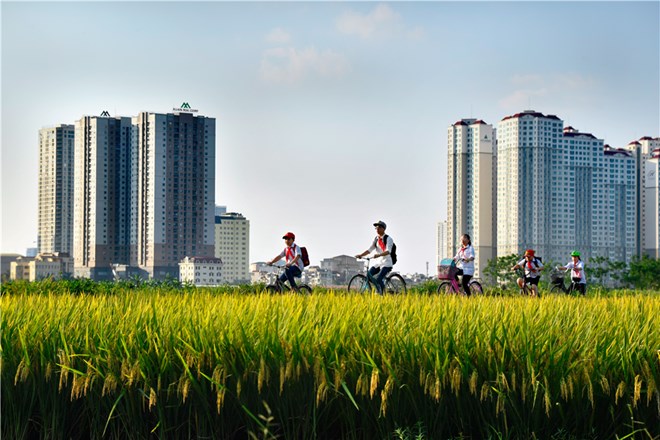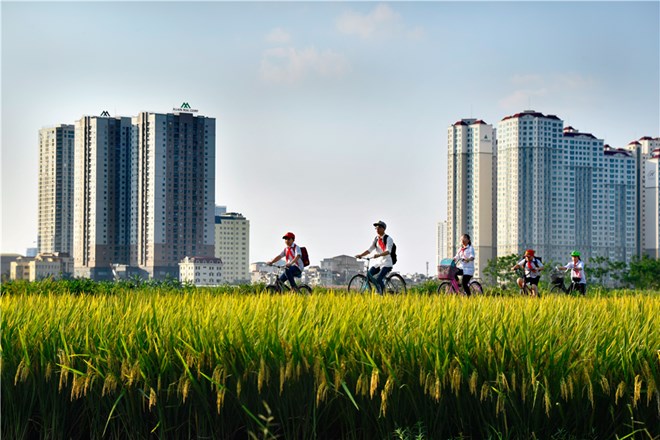
As many as 139 photos depicting the suburban life in Hanoi are being displayed at an exhibition which opened at 45 Trang Tien Street, downtown the capital city on August 3.

A photo on display by Truong The Cau (Source: hanoimoi.com.vn)
The exhibited photos are the winning works of the 48th fine art photography
contest held to celebrate this year’s August Revolution (August 19), National
Day (September 2), the 64th anniversary of Hanoi’s Liberation Day (October 10)
and 10th years of the capital’s boundary expansion.
According to Dao Quang Minh, Vice President of the Hanoi Association of
Photographic Artist and head of the contest’s jury, some 1,750 entries have
been sent to the organizers from 293 photographers since the competition was
launched 2 months ago. Most of the works captured people’s life in four
districts on the outskirts of Hanoi – Dan Phuong, Thanh Tri, Hoai Duc and Dong
Anh which has been recognised as new-style rural districts.
Speaking at the exhibition’s opening ceremony, Deputy Secretary of the
municipal Party Committee Ngo Thi Thanh Hang said a decade after Hanoi’s
boundary expansion, the capital has seen remarkable progress with achievements
recorded in multiple fields, including politics, economy, society, and
culture.
The city’s rural areas have also experienced significant changes, helping Hanoi
lead the country in the new-style rural area building with 76.2 percent of
communes and four districts gaining the status, she noted.
The exhibition is expected to help promote efforts by the administration and
people of Hanoi over the past decade and motivate the better construction of
the city.
Source: VNA
Gongs hold a special place in the cultural and spiritual life of the Muong ethnic people in Hoa Binh province. More than musical instruments, they are an indispensable part of community rituals and collective memory, echoing through generations as a spiritual thread linking the past, present, and future.
Preserving and promoting the cultural values of the Muong ethnic group has become an urgent task in the current context, as many traditional values face the risk of fading away. This effort requires not only protecting the cultural identity but also eliminating outdated customs and developing a modern cultural lifestyle, contributing to sustainable values for the Muong community in Hoa Binh province.
The Muong ethnic culture, deeply rooted in Vietnam’s mountainous north, continues to be preserved and revitalised by dedicated individuals and communities determined to safeguard their ancestral identity.
The Muong group is one of the largest ethnic minorities in Vietnam, primarily found in Hoa Binh province. The Muong people in Hoa Binh boast a rich and diverse cultural treasure that reflects the unique identity of this ethnic group. Accounting for over 63% of the province's population, they have created and preserved numerous distinctive cultural values, contributing to their unique identity. Their cultural heritage is an invaluable asset, at the heart of their national identity, and represents a vibrant spiritual life that must be preserved and promoted in today’s modern world.
For generations, the ethnic communities of Hoa Binh province, particularly the Muong people, have preserved vibrant festivals deeply intertwined with the region’s geography, nature, and social traditions. These celebrations enrich Hoa Binh’s spiritual life and cultural identity, reflecting both folk beliefs and the intermingling of ethnic customs. Many of these festivals have endured the test of time, passed down through generations and continuing to thrive today. Among them, the Khai Ha (Going Down to the Field) festival stands out as one of the most significant events of the Muong ethnic group.
Muong calendar, known as sach doi, is an ancient folk knowledge system developed through observations of the movement of the pleiades star. This unique calendar consists of 12 bamboo sticks, each representing a lunar month. Specific days within each month are marked with distinct symbols, guiding locals in determining auspicious and inauspicious days for important activities.



